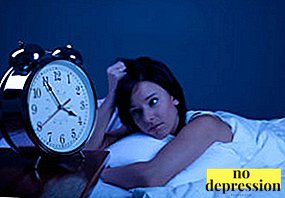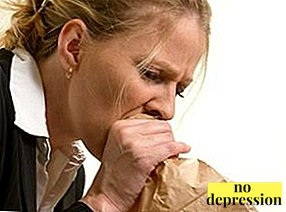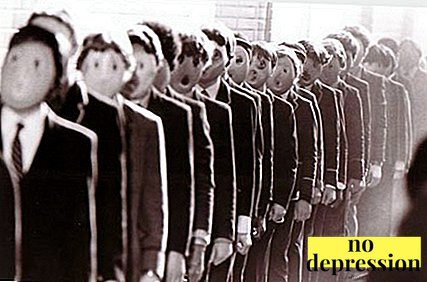Panic attacks - a severe attack of fear or anxiety, which difficult to control yourself.
It is accompanied not only by mental, but also by physical symptoms, such as increased sweating, rapid heartbeat, dramatic changes in blood pressure, trembling of limbs or whole body, nausea, dizziness, chills, heartache, and a sense of lack of air.
For people with phobias and other mental disorders, it is important to know how to deal with panic attacks yourselfto quickly feel better if this condition occurs.
Methods of struggle

In somatic diseases, there are conditions that very similar to panic attackstherefore, before visiting a psychotherapist or starting to try to cope with them yourself, you should undergo a general examination to rule out hyperthyroidism, tumor formations in the adrenal glands, disturbances in the work of the heart.
Some medicines can also cause panic attacks.
There are many methods of dealing with panic attacks, from psychoanalysis to hypnotherapy. But cognitive-behavioral psychotherapy is recognized as the most productive. Her techniques are quite simple, so almost anyone can apply them independently.
Who treats? If panic attacks are observed very often and are accompanied by severe somatic and mental symptoms, better go to a psychotherapist and work with him.
Panic attacks are usually the result of other mental health problems that are not always possible to cope on your own, you can only stop the attack.
The attacks are observed in the following diseases and disorders: depression, post-traumatic stress disorder, phobic disorders, severe neurosis, neurosis-like schizophrenia. If you do not start treatment on time, these conditions will progress.
Panic attacks. A simple solution. Evidence-based medicine:
Cognitive-behavioral psychotherapy: working with automatic thoughts

Automatic thoughts - This is what can cause a panic attack.
Such thoughts are not always properly understood by people, but it is important to know: the correct work with them can radically change a person’s condition.
An example of automatic thoughts: “Something too often has a headache lately. Suddenly it is a sign of cancer? "," I awkwardly took the glass from the counter and spilled a little. Suddenly someone saw it and now laughs at me? ".
Automatic thoughts are often tied to the root causes of the onset of attacks and reflect precisely them, so they can relate to the topic of phobias that a person has, or those negative events that happened to him earlier and left a mark, or something else.
The psychotherapist learns to notice automatic thoughts, gives tasks on their notes. Table of automatic thoughtswhich needs to be drawn in the diary has several sections, among which there are always the following: “Automatic thoughts”, “Refutation of automatic thoughts”.
Also there may be others, for example, an assessment of one's own state of health as a percentage before and after a refutation. When a thought has appeared, it must be fixed and written in another column, why it is irrational.
For most people who work by this method, the condition improves markedly after a few days.
The main problem of this method - distrust on the part of a person who cannot believe that some records can help him. For this reason, the therapist is often needed at least at the initial stage of treatment. It will help you understand how this works and explain why automatic thoughts are irrational.
Changes in attitudes to the somatic symptoms accompanying the attack

People faced with a panic attack are often frightened by what accompanies it.
Their mental state aggravated, they may begin to suspect a terrible disease because of what they feel during an attack.
Cognitive-behavioral psychotherapy makes it possible for a person to understand that rapid heartbeat, pain in the heart, nausea, hotness and cold, pressure jumps are symptoms of a panic attack that are not really a sign of a physical disease and do not threaten a person’s life.
Also, when panic attacks people often resort to the help of hypnotherapists, hoping that those easily, literally in one session, will eliminate panic attacks. However, this works a little bit wrong, but the hypnosis techniques that are used by a qualified hypnotherapist are really able to help.
The hypnotherapist prepares the patient for hypnosis, explains to him the mechanism of the onset of a panic attack, teaches him to relax and trust. This usually takes several sessions. And only after that the patient is immersed in a real trance, which able to really improve the condition.
As an auxiliary methods of psychoanalytic psychotherapy can be used, which is based on psychoanalysis.
It allows a person to find contradictions within himself and solve them in order to get rid of panic attacks in the long term.
What to do during the attack?
The main methods of first aid that will allow a person to quickly overcome a panic attack at the time of the attack:
 Remember that a panic attack in any case will end soon, you just need to wait. Try to calm down, concentrate on the thought that the panic attack is temporary. It will be useful to write on a piece of paper or type in a gadget that is nearby, a phrase like this - “Fear will disappear, I will feel better, everything will be fine, I am stronger than what is happening to me” - and read it several times.
Remember that a panic attack in any case will end soon, you just need to wait. Try to calm down, concentrate on the thought that the panic attack is temporary. It will be useful to write on a piece of paper or type in a gadget that is nearby, a phrase like this - “Fear will disappear, I will feel better, everything will be fine, I am stronger than what is happening to me” - and read it several times.- Switch attention. Excessive concentration on the state of health, on the thoughts that something bad might happen, only aggravates the panic attack and increases its duration, and it becomes more difficult to control it. Try to be distracted. Complicated actions in a panic are difficult to produce, but you can try something simple. Count how many people on a bus or bus stop put on a hat with a pompon, look for all the green or blue objects in the room, play “Cities” or “Words” in your head (you need to think of a word and name another word on its last letter). Such simple methods will quickly make you feel better.
- Breathe smoothly and measured. Concentrate on breathing, try to keep it slow.
How to help yourself at night?
Panic attacks cover people not only during the day, but also at night, sometimes while sleeping or falling asleep. And it is not always possible to turn on the light, to start doing something to reduce panic, especially if it is very important to get enough sleep so as not to sleep on the go while working or studying.
Standard sleep preparation methods:
 Try not to be nervous in the evening, do not read or watch what arousing, disturbing action can have - films with a heavy plot, especially horrors, thrillers, content about war, about suffering, articles about serious diseases. Physical activity is also important to postpone to an earlier time: workouts are useful, but it is better to train three to four hours before sleep or earlier.
Try not to be nervous in the evening, do not read or watch what arousing, disturbing action can have - films with a heavy plot, especially horrors, thrillers, content about war, about suffering, articles about serious diseases. Physical activity is also important to postpone to an earlier time: workouts are useful, but it is better to train three to four hours before sleep or earlier.- Take care of what has always reassured you.: take a bath (if it is with soothing herbs - lavender, mint, melissa, chamomile, then this is an additional plus), read an interesting book, think about something good.
- Make yourself soothing rituals. For example, before bedtime you can brew cocoa or light herbal tea. Reading prose or poems, viewing photos, taking a shower or bath can also be rituals. It is only important to repeat them regularly so that they are associated with sleep and sedation.
You can stop the night attack in the same way as the day attack, unless you have to connect the imagination or use the gadgets that are nearby.
Breathe smoothly, try to focus on something positive, wrap up in a blanket harder, if you have a partner, you can hug him to feel warm and protected.
Some people are helped by pets or fluffy soft toys, which can be ironed when panic rolls in.
How to remove a panic attack at home by yourself:
Home treatment

Drug therapy helps to reduce the frequency of attacks and improve overall health.
However, many of the drugs used in the relief of panic attacks can only be prescribed by the attending physician.
List of medical drugs:
- Antidepressants. Positively affect mood, reduce anxiety. They are used not only to treat depression, but also when working with other mental disorders. Examples: Prozac, Zoloft.
- Sedatives. Reduce fear, anxiety, improve sleep. Examples: Valerian tablets, Novo-Passit.
- Homeopathy. Despite a lot of criticism of homeopathy from the scientific community and evidence of its total inefficiency, many people still believe that homeopathic remedies can help them. Examples: Tenoten.
- Benzodiazepines. Usually assigned in cases where panic attacks are pronounced significantly. Effectively reduce anxiety, fear, have a positive effect on sleep, relax muscles. Examples: Grandaxine, Diazepam, Anaprilin.
- Nootropics. Some nootropic drugs also have a sedative effect, improve mood, and have a positive effect on the blood supply to the brain. Examples: Glycine, Phenibut.
But homeopathy can work except as a placebo. If a person is confident that homeopathy will help him, this may work, but not because it is effective, but because he has convinced himself of this.
Traditional methods, especially herbal medicine, can also improve the condition of a person suffering from panic attacks.
Examples of the best tools:
- Broth sedative herbs. In pharmacies, you can buy ready-made sedative charges, packaged in tea bags, which you need to brew in a mug according to the instructions. Typically, such fees include chamomile, motherwort, valerian, mint, lemon balm, hop cones, licorice.
- Bathing with soothing herbs: mint, melissa, chamomile, motherwort. They can be collected independently or bought in special stores, pharmacies.
About the main treatment errors panic attacks in this video:
other methods
Meditation

She is considered one of the techniques. relaxation.
If you learn and practice it regularly, it will help you to feel good throughout your life.
Regular meditations will not help to get rid of panic attacks immediately, but six months or a year after the start, most people show lasting improvements.
And although specialized types of meditation are difficult to master, basic relaxation meditation can master any.
- take a comfortable posture (contrary to the conviction of many, it is not necessary to meditate exclusively in the lotus position);
- concentrate on breathing and try to relax;
- thoughts in the head during meditation can be, but should not disturb you, cause emotions, so if they appear, switch your attention to breathing and to the general relaxation of the body;
- if it is difficult to meditate in silence, turn on the music.
Breathing exercises, using the package
Breath in a pack - A long used technique that allows you to get rid of hyperventilation.
When a person panics, his brain is overly saturated with oxygen. If you breathe in a paper bag, its amount will decrease, and panic will recede.
Take a paper bag, press it to your nose and mouth and start breathing with your mouth into it. Exhalation is also performed through the mouth, so that the bag is filled with carbon dioxide.
Other breathing exercises:
 During an attack, to make breathing smoother and slower, hold it for 5-10 seconds. After that, slowly inhale fully and exhale slowly.
During an attack, to make breathing smoother and slower, hold it for 5-10 seconds. After that, slowly inhale fully and exhale slowly.- Put your hand just below the solar plexus and begin to breathe slowly and slowly. Concentrate on the sensation of movement at hand and on breathing. You can also imagine how the air fills the lungs and out of them.
Autotraining
Autotraining is essentially self-hypnosis method. However, it is unlikely to help stop the attacks, but it can improve a person's condition between attacks, reduce his internal stress, calm down.
During an attack, a person is too panicking to respond to standard methods of auto-training, so this may not work.
Also autotraining will not be effectiveif panic attacks are too strong and other treatments are not used.
Auto-training session takes place in three stages. On the first, a person plunges into a state of trance, on the second he gives himself certain attitudes aimed at fighting panic attacks, and on the third he wakes up.
If a hold them regularlyUsing recommendations from specialized books and including audio recordings on auto-training, you can achieve good results.
Panic reactions can be cured by purposefully practicing techniques, consulting psychotherapists and solving the accumulated problems in various ways.
However, it is difficult to say whether it is possible to cure them forever. Life is changeable, full of stress and anxiety, therefore, under certain conditions, especially if a person is sensitive, they may come back again.
Prevention

To reduce the risk of seizures returning, important:
- get enough sleep regularly;
- move more, train, do gymnastics;
- to walk outside;
- communicate with good, pleasant people and get rid of toxic communication;
- avoid stress;
- do your favorite things more often;
- read art books: reading can prevent depression and at times improve the state;
- find effective methods of complacency and use them when necessary.
It is also important to listen to yourself and to rationally alternate work and rest so that the vice of stress does not lead to the development of severe disturbances.
If a to find a balance in the flow of life, fill life with joy, satisfaction and tranquility as much as possible, the likelihood that panic attacks will return will decrease to a minimum.
Preparations for panic attacks:

 Remember that a panic attack in any case will end soon, you just need to wait. Try to calm down, concentrate on the thought that the panic attack is temporary. It will be useful to write on a piece of paper or type in a gadget that is nearby, a phrase like this - “Fear will disappear, I will feel better, everything will be fine, I am stronger than what is happening to me” - and read it several times.
Remember that a panic attack in any case will end soon, you just need to wait. Try to calm down, concentrate on the thought that the panic attack is temporary. It will be useful to write on a piece of paper or type in a gadget that is nearby, a phrase like this - “Fear will disappear, I will feel better, everything will be fine, I am stronger than what is happening to me” - and read it several times. Try not to be nervous in the evening, do not read or watch what arousing, disturbing action can have - films with a heavy plot, especially horrors, thrillers, content about war, about suffering, articles about serious diseases. Physical activity is also important to postpone to an earlier time: workouts are useful, but it is better to train three to four hours before sleep or earlier.
Try not to be nervous in the evening, do not read or watch what arousing, disturbing action can have - films with a heavy plot, especially horrors, thrillers, content about war, about suffering, articles about serious diseases. Physical activity is also important to postpone to an earlier time: workouts are useful, but it is better to train three to four hours before sleep or earlier. During an attack, to make breathing smoother and slower, hold it for 5-10 seconds. After that, slowly inhale fully and exhale slowly.
During an attack, to make breathing smoother and slower, hold it for 5-10 seconds. After that, slowly inhale fully and exhale slowly.

